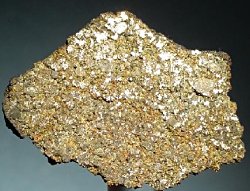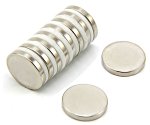
Tetrataenite-photo by Rob Lavinsky, iRocks.com
 Tetrataenite-photo by Rob Lavinsky, iRocks.com | Outer-space Alternative to Today's High-Performance Magnets |

High-performance magnets, often referred to as permanent magnets, are critical for many modern technologies, from electric cars and wind turbines to medical devices and electronics. At present such magnets are neodymium-based. A neodymium magnet (also known as Neo magnet) is a permanent magnet made from an alloy of neodymium, iron and boron which forms a Nd2Fe14B tetragonal crystalline structure. Today neodymium magnets are the strongest permanent magnets available commercially.
Neodymium (atomic number 60) belongs to the Rare Earths family. Rare Earths are not actually that rare but mining of those metals is difficult and at present most (81%) are sourced from China. Given the present geopolitical climate an alternative would be extremely useful.
Tetrataenite, an iron-nickel alloy with a particular ordered atomic structure, is one of the most promising of those alternatives. Tetrataenite is a native metal alloy which was recognised as mineral in 1980. Its name comes from the tetragonal crystal structure which it forms and because it is closely related to another member of the iron-nickel mineral known as Taenite. A tetragonal crystal structure is a stretched cube along one vector so the cube becomes a rectangular prism with a square base.
Tetrataenite has strong residual magnetism which makes that metal an attractive substitute for neodymium-based magnets. However at present there are no known tetrataenite deposits on Earth. It forms naturally in iron meteorites which contain taenite - therefore most known tetrataenite deposits are literally floating about in space.
The present theory is that with high Ni content (as much as 52%) at a temperature below 320oC, tetrataenite is broken down from taenite and distorts its cubic crystal structure to form the tetragonal L10 structure. In meteorites that process is thought to take millions of years.
Since its discovery, different techniques have been used to produce tetrataenite in the laboratory. In the 1960s some success was obtained by bombarding iron-nickel alloys with neutrons, enabling the atoms to form the desired ordered stacking. However, this technique was not suitable for large-scale production. But in the most recent studies researchers from the University of Cambridge, working with colleagues from Austria, found a new approach which succeeded in obtaining small amounts of tetrataenite by simply adding phosphorus to the mixture. (The team had observed that phosphorus was always present in the meteorites which contain tetrataenite.)
The technique which they used was very simple - melt the Ni-Fe alloy, add an appropriate amount of phosphorus and pour it into a mold. The formation of tetrataenite was observed shortly after casting. Casting alloys were used in their as-cast condition without any mechanical or heat treatment after being cast.
As Lindsay Greer (co-author of the recent research paper) explains: "The previous view in the field was that you couldn't get tetrataenite unless you did something extreme, because otherwise you'd have to wait millions of years for it to form. This result represents a total change in how we think about this material."
So how does the team explain their results? By their theory phosphorus, which is present in meteorites, allows the iron and nickel atoms to move faster, enabling them to form the necessary ordered stacking without waiting for eons.
Will their technique work to produce tetrataenite on an industrial scale? The researchers are hoping to team up with major magnet manufacturers to determine just that. Both nickel and iron are abundant and much cheaper than Rare Earths so the use of tetrataenite as a permanent magnet would certainly be a game changer.
Journal Reference:
| _______________________________ | ||||
| Home | | | Shopping | | | Database |
© Biscuit Software 2004-2019
All rights reserved